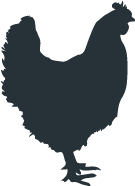Veterinary advice should be sought from your local veterinarian before applying any treatment or vaccine. Not sure who to use? Look up veterinarians who specialize in poultry using our directory listing. Find me a Vet
| Name | Summary | |
|---|---|---|
| Supportive care | Isolate the bird from the flock and place in a safe, comfortable, warm location (your own chicken "intensive care unit") with easy access to water and food. Limit stress. Call your veterinarian. | |
| Tiamulin (Denagard) | 12.5-25 mg/kg body weight PO q24h for 3 to 5 days | M Woodward et al., 2015; C Stephens et al., 2010; B Speers; D Burch et al., 2007 |
| Lincomycin | 20 mg/kg body weight PO q24h for 5 days | C Stephens et al., 2010 |
| Cinnamon (Cinnamomum verum) | Reduction of Brachyspira colonization in young pullets was obtained, in a curative way, in an in vivo study using feed supplemented with coated trans-cinnamaldehyde at a dose of 500 mg/kg | M Verlinden et al.,2013; F Omonijo et al., 2017 |
| Probiotics (Lactobacillus reuteri) | When added to drinking water of hens it provided protection against infection with Brachyspira . | L Mappley et al., 2013 |

© 2025 PoultryDVM All Rights Reserved.